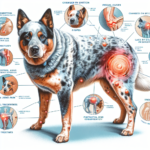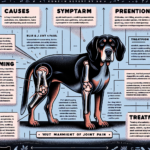Great Pyrenees Joint Pain: Causes, Symptoms, Prevention, and Treatment

Introduction
The Great Pyrenees, also known as the Pyrenean Mountain Dog, is a majestic and ancient breed known for its protective nature and striking appearance. Originating from the Pyrenees Mountains between France and Spain, this breed was historically used to guard livestock against predators. With their thick, weather-resistant coats and imposing size, Great Pyrenees are both beautiful and functional. They are known for their calm demeanor, loyalty, and gentle disposition, making them excellent family pets and guardians.
Like many large breeds, the Great Pyrenees is prone to certain health issues, with joint pain being a significant concern. Joint health is crucial for maintaining the mobility and quality of life of these dogs, given their size and the physical demands often placed on them. Understanding the causes, symptoms, prevention, and treatment of joint pain in Great Pyrenees is essential for any owner looking to provide the best care for their canine companion.
Breed-Specific Joint Pain Risks
Genetic Predisposition
The Great Pyrenees is genetically predisposed to several joint-related issues, including hip dysplasia, elbow dysplasia, and arthritis. Hip dysplasia is a condition where the hip joint does not fit properly into the hip socket, leading to pain and mobility issues. Elbow dysplasia involves abnormal development of the elbow joint, causing lameness and discomfort. Arthritis, a degenerative joint disease, is also common in this breed, particularly as they age.
Age-Related Risks
As Great Pyrenees age, the risk of developing joint pain increases. Typically, signs of joint issues may start to appear in middle age, around 5 to 7 years old. However, some dogs may show symptoms earlier, especially if they have a genetic predisposition. It’s important for owners to monitor their dogs closely as they age and to be aware of any changes in mobility or behavior that could indicate joint pain.
Activity Level and Joint Stress
The Great Pyrenees is a working breed, often used for guarding livestock. This role requires them to be active and agile, which can put significant stress on their joints. Even as pets, their large size and weight can contribute to joint wear and tear. While regular exercise is essential for their overall health, it’s important to balance activity levels to avoid overexertion and joint damage.
Common Symptoms of Joint Pain in Great Pyrenees
General Symptoms
- Limping or favoring one leg
- Stiffness, especially after rest
- Reluctance to move, jump, or climb stairs
- Decreased activity or playfulness
- Visible discomfort or pain when touched
- Swelling around the joints
Breed-Specific Symptoms
In Great Pyrenees, joint pain may manifest more noticeably due to their size and weight. Owners may observe a pronounced limp or difficulty getting up from a lying position. Additionally, these dogs may become more sedentary and less willing to engage in activities they previously enjoyed.
When to Consult a Vet
If you notice any of the above symptoms in your Great Pyrenees, it’s important to consult a veterinarian promptly. Early diagnosis and intervention can help manage joint pain more effectively and improve your dog’s quality of life. Regular veterinary check-ups are also crucial for monitoring joint health and catching any issues early.
Preventive Measures for Joint Health
Exercise Recommendations
Regular, moderate exercise is key to maintaining joint health in Great Pyrenees. Activities such as walking, swimming, and gentle play can help keep their joints flexible and muscles strong without causing excessive stress. Avoid high-impact activities like jumping or running on hard surfaces, which can exacerbate joint issues.
Dietary Suggestions
A balanced diet rich in essential nutrients is vital for joint health. Consider incorporating foods or supplements that contain glucosamine, chondroitin, and omega-3 fatty acids, which support joint function and reduce inflammation. Consult your veterinarian for specific dietary recommendations tailored to your dog’s needs.
Weight Management
Maintaining a healthy weight is crucial for reducing joint stress in Great Pyrenees. Excess weight can exacerbate joint pain and lead to further complications. Monitor your dog’s weight regularly and adjust their diet and exercise routine as needed to keep them at an optimal weight.
Early Screening and Monitoring
Regular veterinary check-ups and early screening for joint issues can help catch problems before they become severe. X-rays and other diagnostic tools can identify conditions like hip dysplasia or arthritis early on, allowing for more effective management and treatment.
Treatment Options for Joint Pain
Non-Surgical Treatments
Non-surgical treatments for joint pain in Great Pyrenees include medications, physical therapy, and lifestyle adjustments. Anti-inflammatory drugs and pain relievers can help manage symptoms, while physical therapy can improve mobility and strengthen muscles. Lifestyle changes, such as providing a comfortable bed and avoiding stairs, can also alleviate joint stress.
Surgical Options
In severe cases, surgical intervention may be necessary. Common surgeries for joint pain include hip replacement, arthroscopy, and joint fusion. These procedures can significantly improve mobility and reduce pain, but they come with risks and require a thorough discussion with your veterinarian.
Alternative Therapies
Alternative treatments like acupuncture, hydrotherapy, and massage can also benefit Great Pyrenees with joint pain. These therapies can help reduce pain, improve circulation, and enhance overall well-being. Always consult your veterinarian before starting any alternative treatments to ensure they are appropriate for your dog.
Lifestyle and Management Tips
Daily Care Routine
A consistent daily care routine can help manage joint pain in Great Pyrenees. This may include gentle exercise, a balanced diet, and regular medication or supplements. Providing a comfortable sleeping area and avoiding activities that strain the joints are also important.
Modifying the Home Environment
Making your home more accessible can significantly improve your dog’s comfort. Consider installing ramps for stairs, using non-slip mats, and providing orthopedic beds. These modifications can help reduce joint stress and make daily activities easier for your dog.
Long-Term Management
Long-term management of joint pain involves regular veterinary check-ups, ongoing treatment, and lifestyle adjustments. Keeping your dog active and engaged, while avoiding activities that exacerbate joint pain, is crucial. Monitoring their condition and adjusting their care routine as needed will help ensure they remain happy and healthy.
FAQs About Great Pyrenees and Joint Pain
What are the early signs of joint pain in Great Pyrenees?
Early signs of joint pain include limping, stiffness, reluctance to move, and decreased activity. If you notice any of these symptoms, consult your veterinarian for a thorough evaluation.
Can joint pain in Great Pyrenees be prevented?
While genetic predispositions cannot be entirely prevented, maintaining a healthy weight, providing regular exercise, and ensuring a balanced diet can help reduce the risk of joint pain. Early screening and monitoring are also essential for catching issues early.
Are there specific exercises that are better for Great Pyrenees with joint pain?
Low-impact exercises like walking and swimming are ideal for Great Pyrenees with joint pain. These activities help maintain mobility and muscle strength without putting excessive stress on the joints.
What dietary supplements are beneficial for joint health in Great Pyrenees?
Supplements containing glucosamine, chondroitin, and omega-3 fatty acids are beneficial for joint health. These nutrients support joint function and reduce inflammation. Always consult your veterinarian before adding supplements to your dog’s diet.
When should I consider surgery for my Great Pyrenees’ joint pain?
Surgery should be considered when non-surgical treatments are no longer effective, and your dog’s quality of life is significantly impacted. Discuss the risks and benefits of surgical options with your veterinarian to make an informed decision.
Conclusion
Joint pain is a common concern for Great Pyrenees, but with proper care and attention, it can be managed effectively. Understanding the causes, symptoms, prevention, and treatment options is essential for maintaining your dog’s joint health and overall well-being. By taking preventive measures, providing appropriate treatment, and making necessary lifestyle adjustments, you can help ensure your Great Pyrenees remains active and happy throughout their life. Regular veterinary consultations are crucial for monitoring their condition and making informed decisions about their care.




